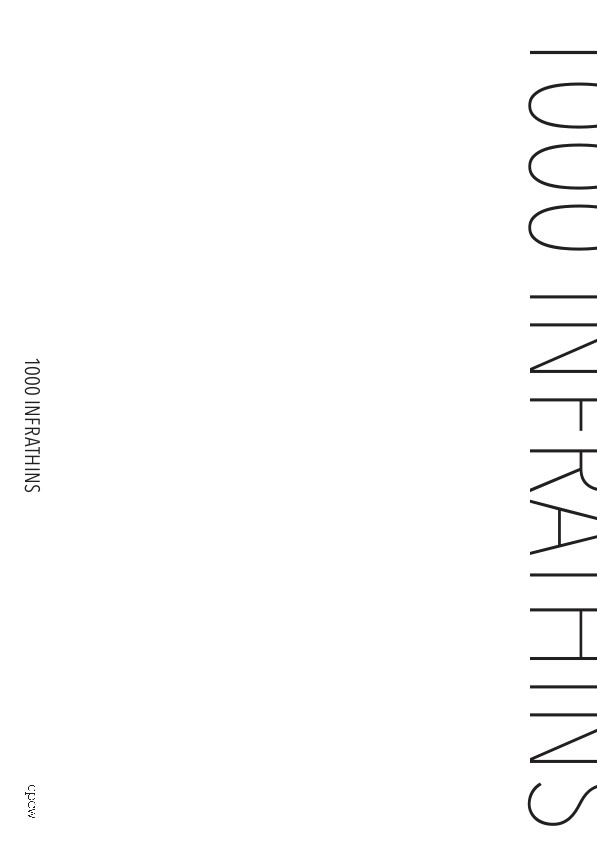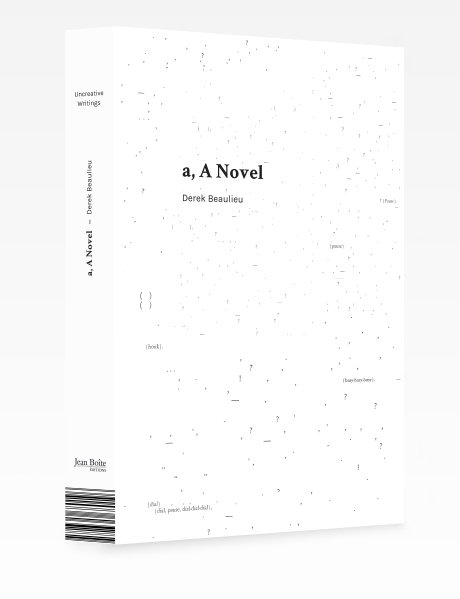1000 Infrathins (2018)
Filed under artist publishing | Tags: · aesthetics, infrathin

“Marcel Duchamp gave six instances of the infrathin. We wrote 1000 of them.”
“What is infrathin? It’s not really clear. Purposely. The French word inframince (translated into English as infrathin) was coined by Marcel Duchamp, but in typical Duchampian fashion, he claimed that it couldn’t be defined. Instead, he insisted that one could only give examples of it. Over the course of his life, he gave a few:
– The warmth of a seat (which has just/been left) is infra-thin.
– When the tobacco smoke smells also of the mouth which exhales it, the 2 odors marry by the infra-thin.
– Velvet trousers, their whistling sound is an infra-thin separation signaled.
Without getting too specific, we can surmise that infranthin is the space between spaces, the sound between sounds, the sensation between sensations; neither here nor there, this nor that, but both—all at the same time. The closest metaphor is the fourth dimension, which is best illustrated by a cube collapsing in on itself and at the same time expanding. I know. It’s not very helpful. But that’s the whole point—it’s a moving target, a ball of contradictions; just when you think you’ve got it, it’s escaped you.”
Edited by Kenneth Goldsmith
Authors: Cecily Chen, Andrew Howard, William Kahn, Grace Knight, Jonida Kupa, Amy Marcus, Charlie Sosnick, Zoe Stoller
Publisher The Center for Programs in Contemporary Writing, University of Pennsylvania, 2018
121 pages
Derek Beaulieu: a, A Novel (2017)
Filed under artist publishing, poetry | Tags: · conceptual writing, uncreative writing, visual poetry

“Derek Beaulieu’s a, A Novel is an erasure-based translative response to Andy Warhol’s eponymous novel. Beaulieu carefully erases all of the text on each page of the original work, leaving only the punctuation marks, typists’ insertions and onomatopoeic words. The resultant text is a novelistic ballet mécanique, a visual orchestration of the traffic signals and street noise of 1960’s New York City. This visually powerful half score/half novel highlights the musicality of non-narrative sounds embedded within conversation.
Published in December 1968, Andy Warhol’s a, A Novel consists solely of the transcribed conversations of Factory denizen Ondine (Robert Olivo). Ondine’s amphetamine-addled conversations were captured on audiotape as he haunted the Factory, hailed cabs to late-night parties and traded gossip with Warhol and his coterie. The tapes were roughly transcribed by a small group of high school students. Rife with typographic errors, censored sections, and a chorus of voices, the 451 pages of transcription became, unedited, “a new kind of pop artefact”. These pages emphasize transcription over narration, hazard over composition.
In his book, Derek Beaulieu offers a radical displacement of Andy Warhol’s work. He erases the novel’s speaking characters – members of the mid 1960’s New York avant-garde – and preserves only the musicality of their conversations. Beaulieu perfectly provides a tangible example of Theodor Adorno’s theory elaborated in his essay ”Punctuation Marks”, in which he argues that punctuation marks are the “traffic signals” of literature and that there is “no element in which language resembles music more than in the punctuation marks”.
This visual poetry is accompanied by an essay by Gilda Williams, “Breaking Up is Hard to Do. Men, Women, and Punctuation in Warhol’s Novel a”. Her deep knowledge of both Andy Warhol’s work and the history of contemporary art explores the complicated history of the original novel and highlights the urgent and precise spirit of Derek Beaulieu’s work—the work of an artist who situates Uncreative Writing at the core of contemporary literature and artistic labour.”
Publisher Jean Boîte Éditions, Paris, 2017
ISBN 9782365680196
478 pages
via author
PDF (24 MB)
Comment (0)Pauline Oliveros: Sonic Meditations (1974)
Filed under artist publishing, musical score | Tags: · listening, sound

“25 meditations for musicians of all ages and skill levels, to help them learn how to focus on, listen to, and produce sound naturally. An important work in the development of Oliveros’ Deep Listening.”
Publisher Smith Publications, Baltimore, MD, [1974]
[33] pages
Commentary: Pauline Oliveros (Painted Bride Quarterly, 1976), William Osborne (2000), Kerry O’Brien (New Yorker, 2016), Bradford Bailey (The Hum, 2016), Emma Warren (Bowers & Wilkins, 2017).
See also Oliveros in UbuWeb Sound and UbuWeb Film
Comment (0)
